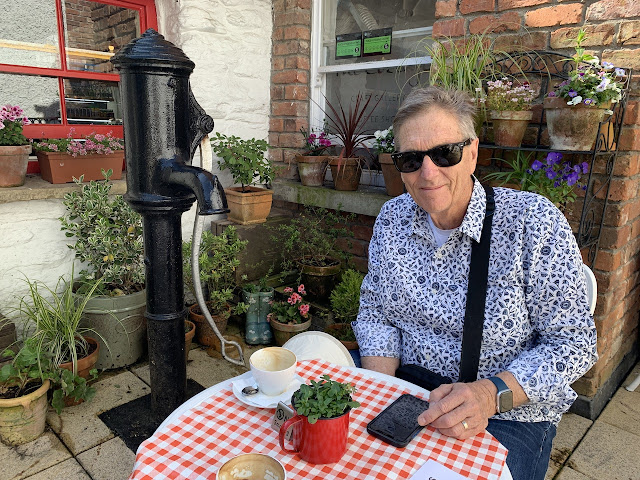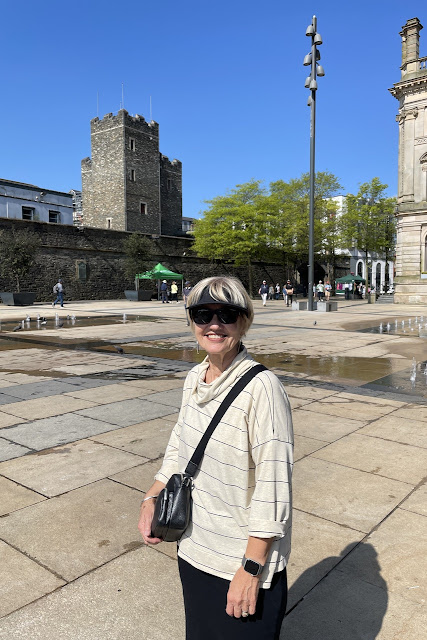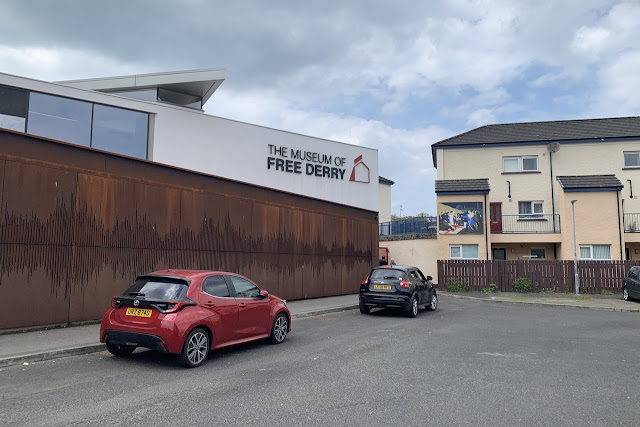We had time afterwards for an initial look at the city's famous Guildhall before joining a guided walking tour of Derry's Bogside (predominantly Catholic area) at 11.00am.
We joined the Bogside History Tour led by Paul, son of Patrick "Paddy" Doherty (age 31), one of 13 people shot dead when British soldiers opened fire on marchers in a Civil Rights march in Derry's Bogside on 30 January 1972 - so called "Bloody Sunday". Paul was in the march too on that day (aged 14) as was his mother and grandparents ... so he knew a lot about what happened, and why, and he had a lot to tell us about.In his two hour tour he talked about government oppression of the predominantly Catholic population of Derry, the struggles for civil rights, the Battle of the Bogside (a 3 day riot in August 1969), how the subsequent internment laws led to the marches and riots preceding Bloody Sunday, the establishment of Free Derry from 1969-1972, and the events of Bloody Sunday after that. It was all powerful stuff!!
Just like in Belfast the murals of Bogside are powerful and lasting symbols of the struggles.
The Peace Mural of Derry-Londonderry was erected in 2004 by The Bogside Artists, representing "a symbol of hope for the future". It's painted on a building in Rossville Street where British soldiers opened fire on unarmed protesters on Bloody Sunday.
This gable end of a house (now demolished) was first painted by teenager John Caker Casey in 1969. "Free Derry" was the name given to those areas barricaded off from police from 1969-1972. The barricades were finally removed in July 1972, a few months after Bloody Sunday as the police and army gained control - the end of Free Derry. The terrace row of houses behind the mural has been demolished but the mural lives on and has been frequently repainted. Today it also recognizes the plight of Palestinians in Gaza. This is the famous mural of an iconic image of Bloody Sunday - a group of men led by a local priest waving a white flag, carrying the body of Jackie Duddy, the first fatality of the day.
Early marches in Derry's Bogside were inspired by the campaigns of the American Civil Rights movement and were peaceful demonstrations. We used to hear of the "sectarian violence" in Ireland during The Troubles - not understanding that it was really about Civil Rights, the abuse of power and colonial oppression.
This famous mural is an image from the Battle of the Bogside in 1969. A young boy wears a gas mask (to protect him against CS gas) and is holding a petrol bomb made from a milk bottle. This mural was painted in 1994 the year peace talks began.
Bernadette McAliskey addressing the crowds in the Bogside - she was later elected to parliament at the age of 21.
The are signs of support for the Palestinians in Gaza everywhere in the Bogside, just like in The Falls area of Belfast.Che Guevera is much admired by Irish revolutionaries. He even has some Irish heritage apparently (he has an ancestor from Galway in the dim distant past). The famous graphic image of Che Guevera seen in posters and on products all over the world was designed by an Irish graphic artist.
This was quite an emotional moment for all of us as Paul talked in front of the mural of the 13 victims of the Bloody Sunday massacre. His father's portrait is on the top left hand side.
It took 38 years and the conclusion of the Saville Report in 2010 for the British government to finally admit that the actions of the British Army on Bloody Sunday were "unjustified and unjustifiable" and that the 13 victims were innocent of any crime. Families of the victims and all the people involved had to wait 38 years for justice - no wonder the pain of this time is still so raw for people here.
Paul's mother was also imprisoned in the months after Bloody Sunday in the security crackdown that followed. She was imprisoned without trial, leaving Paul and 5 children under 11 on their own!
Paul's mother was also imprisoned in the months after Bloody Sunday in the security crackdown that followed. She was imprisoned without trial, leaving Paul and 5 children under 11 on their own!
The Museum of Free Derry has been built on the edge of an open area that was subject to British army fire and a number of deaths, on Bloody Sunday. A section of wall pocked with massive bullet holes has been retained as a sober reminder of the barbarism of the army's attack on unarmed people that day. The museum itself, though small and restrained in its presentation, tells a very powerful story of The Troubles in Derry and we spent some time there at the end of our guided walk with Paul.
Quite near to this is the so called "Agro Corner" - the corner of Rossville and Upper William Street, the site of barricades and many battles 1969-1972.
Feeling somewhat depleted by all this we went back to that lovely cafe in Derry's Craft Village for a cup of tea and a restorative lunch. This cafe has been voted best scone makers in Northern Ireland for a number of years now, so we treated ourselves to one for dessert after our chicken salad. Scones are a real thing here in Ireland - a real staple for breakfast, lunch and anytime in between - and they are very good indeed!!
After lunch we took a long look at the Derry-Londonderry Plantation of Ulster exhibition at the Guildhall. It was all about the colonisation of Ulster during the reign of King James 1 in the 17th century - and all of the ramifications of that program in the centuries that followed. The Plantation of Ulster is what changed Northern Ireland for ever and made it what it is (or isn't) today! Our heads were exploding with information and complexity after all this!
We now know the Guilds of London were integral to the Plantation of Ulster - and this building symbolises all that.
We walked the old city wall of Derry-Londonderry afterwards - 1 mile around, as they say and still standing strong since it was constructed in 1613-1618.
Quite near to this is the so called "Agro Corner" - the corner of Rossville and Upper William Street, the site of barricades and many battles 1969-1972.
Feeling somewhat depleted by all this we went back to that lovely cafe in Derry's Craft Village for a cup of tea and a restorative lunch. This cafe has been voted best scone makers in Northern Ireland for a number of years now, so we treated ourselves to one for dessert after our chicken salad. Scones are a real thing here in Ireland - a real staple for breakfast, lunch and anytime in between - and they are very good indeed!!
After lunch we took a long look at the Derry-Londonderry Plantation of Ulster exhibition at the Guildhall. It was all about the colonisation of Ulster during the reign of King James 1 in the 17th century - and all of the ramifications of that program in the centuries that followed. The Plantation of Ulster is what changed Northern Ireland for ever and made it what it is (or isn't) today! Our heads were exploding with information and complexity after all this!
We now know the Guilds of London were integral to the Plantation of Ulster - and this building symbolises all that.
We walked the old city wall of Derry-Londonderry afterwards - 1 mile around, as they say and still standing strong since it was constructed in 1613-1618.
One of the first things we sighted from the wall was the famous Derry Girls mural - another twist on life in Derry (for teenagers) in the early 1990s era of The Troubles.
A battlement on the old city wall - near where soldiers could "sally forth" to make surprise attacks.
A view over to the Protestant west side......... Their mural states that "Londonderry West Bank Loyalists still under siege NO SURRENDER". But there are no guided history walks on the Loyalist side in Derry to hear their side of the story!
A view of the Bogside from the old city wall - a lot less crowded than it was in the late 1960s
A view of a city street of terraces from the old city wall ........
Derry-Londonderry's Peace Bridge over the River Foyle opened in 2011. Part funded by the EU it was intended to improve relations between the largely unionist Waterside on the east bank with the largely nationalist City side on the west bank by "bringing the two sides together in peace".
In the spirit of reconciliation we walked over to the east bank to test the theory out.
Feeling a bit over exerted by now we ended off our day with a pint of Guinness at Tracy's Bar. Peadar O'Donnell's, next door, was just too crowded for us today. There was a Rangers vs Celts Football game on this afternoon in the Scottish Premier League and all the locals were going for the Celts of course. And they ended up winnin' - so it was a very loud and lively crowd by the time we ordered our pints at Tracy's Bar.
A battlement on the old city wall - near where soldiers could "sally forth" to make surprise attacks.
A view over to the Protestant west side......... Their mural states that "Londonderry West Bank Loyalists still under siege NO SURRENDER". But there are no guided history walks on the Loyalist side in Derry to hear their side of the story!
A view of the Bogside from the old city wall - a lot less crowded than it was in the late 1960s
A view of a city street of terraces from the old city wall ........
Derry-Londonderry's Peace Bridge over the River Foyle opened in 2011. Part funded by the EU it was intended to improve relations between the largely unionist Waterside on the east bank with the largely nationalist City side on the west bank by "bringing the two sides together in peace".
In the spirit of reconciliation we walked over to the east bank to test the theory out.
Feeling a bit over exerted by now we ended off our day with a pint of Guinness at Tracy's Bar. Peadar O'Donnell's, next door, was just too crowded for us today. There was a Rangers vs Celts Football game on this afternoon in the Scottish Premier League and all the locals were going for the Celts of course. And they ended up winnin' - so it was a very loud and lively crowd by the time we ordered our pints at Tracy's Bar.
Walking back up through Brooke Park late this evening I took this pic of "A Stitch in Time" - an LED light installation on top of a former shirt making factory in Rosemount Avenue (near our B&B) celebrating Derry's long and illustrious history of shirtmaking - the first large scale manufacturing beginning in 1857 - and continuing right through to the 1990s - and employing thousands of "Derry girls" over that time.




























.jpeg)

No comments:
Post a Comment